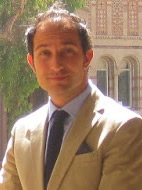Tag Archives: Convertino
News
Virtual Forum: Fan and Convertino discuss Urban Form, City Scaling, and City Typologies
Join us Friday for a discussion on: Urban Form, City Scaling, and City Typologies
Led by: Yingling Fan (Professor, Urban and Regional Planning, University of Minnesota) & Matteo Convertino (Asst Professor, School of Public Health, University of Minnesota)


Friday February 10, 2:30 to 4:30 PM Central
To view or join the discussion on Friday: Join Here, Access Code: 383-419-437.
Participants can view PowerPoint presentations on these topics before the forum by opening the PDFs here and here. (For copies of the narrated PowerPoints, contact srn.cities@gmail.com).
These lectures and discussions are part of a course offered by the MSSTEP Program and the Sustainable Healthy Cities Network, Infrastructure Transformations for Sustainable Healthy Cities: Design and Policy.
News
IonE Fellow to Lead Global Project on Sustainable Cities

What is a healthy city? How does society weigh the conveniences of transportation, readily available water and electricity, and placement of that new shopping center against the environmental impacts of those assets?
With more than half the world’s population living in cities, building resilient and healthy communities has never been more important. Estimates indicate that by 2050, three billion more people — two-thirds of the world’s population — will inhabit urban areas, increasing pressure on water, energy and land resources.
University of Minnesota researchers — including several Institute on the Environment resident fellows — are part of a global team that has received a $12 million award from the National Science Foundation to bring together a unique network of scientists, industry leaders and policy partners committed to building better cities of the future.
“We have to think in new ways about a city’s physical infrastructure to develop sustainable solutions,” Anu Ramaswami, professor in the Humphrey School of Public Affairs, IonE resident fellow and lead investigator and director for the project, said in a press release. “Understanding that these systems are interconnected serves as a foundation for this work. For example, urban farms wouldn’t work very well without thinking about water, energy and transportation infrastructure, as well as people, markets and policies.”
In this video, Ramaswami and several other members of the project team explain how the project will be implemented.
IonE resident fellows Matteo Convertino, assistant professor in the School of Public Health; Julian Marshall and Paige Novak, professors in the College of Science and Engineering; and Elizabeth Wilson, associate professor in the Humphrey School, are co-investigators on the project.
IonE’s nearly 70 resident fellows — faculty with appointments throughout the University of Minnesota system who come together here to share ideas, inspiration and innovation across disciplinary boundaries — are among the shining stars of IonE’s signature approach to addressing global grand challenges.
This article was originally posted by the Institute on the Environment.
News
SRN Faculty Presents to the White House Office of Science and Technology Policy

University of Minnesota assistant professor in the Division of Environmental Health Sciences and Institute on the Environment fellow, Matteo Convertino, was selected as one of sixteen teams to participate as a finalist in the “Integrating Prediction and Forecasting Models for Decision-Making: Dengue Epidemic Prediction” workshop in Washington D.C. on September 21, 2015. The workshop is the fourth in a series convened by the White House Office of Science and Technology Policy (OSTP) in support of the Predict the Next Pandemic (PtNP) Initiative. The workshop brought together federal and non-federal stakeholders to discuss the development and application of models for forecasting dengue epidemics, and contribute to the broader objective of applying prediction and forecasting models to support public health and national security decision-making. The top scoring teams in the dengue forecasting pilot program gathered to discuss their findings and capabilities in dengue forecasting.
The White House Office of Science and Technology Policy (OSTP) established the new interagency Pandemic Prediction and Forecasting Science and Technology (PPFST) Working Group to advance specific prediction and forecasting priorities in support of the PtNP initiative. The Dengue Forecasting Project was launched on June 5, 2015, with the announcement of key forecasting targets and data that could be used to develop forecasting models. Sixteen teams developed models and submitted final forecasts for evaluation by an interagency group comprised of experts at CDC, DoD, and NOAA. Activities with the selected teams will continue within the Predict the Next Pandemic (PtNP) Initiative, with follow-up work for Dengue and other infectious diseases. Following the Dengue forecast project Dr. Convertino has been invited to participate to the ’15/’16 Flu Forecast challenge. All these challenges are in line with the OSTP/CDC effort to build a biosurveillance cyberinfrastructure that makes reliable daily forecasts of infectious diseases.




